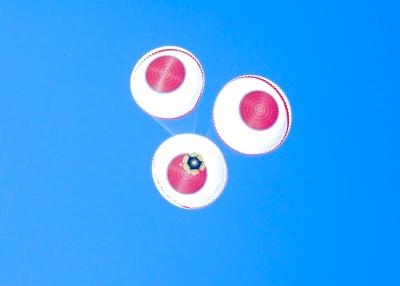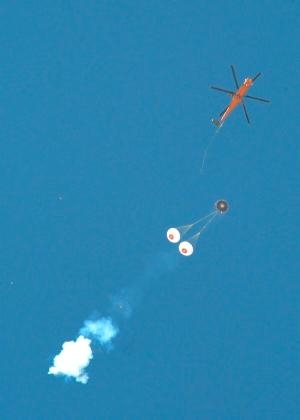Second CST-100 Drop Test Demonstrates Parachute And Air Bag System Performance
The second parachute drop test of the Boeing's Crew Space Transportation (CST)-100 spacecraft went as planned on May 2 at the Delamar Dry Lake Bed near Alamo, NV. The test demonstrated the performance of the entire landing system.

An Erickson Air Crane helicopter lifted the CST-100 test article to about 14,000 feet and initiated a drogue parachute deployment sequence that was followed by deployment of the main parachute. The capsule descended to a smooth ground landing, cushioned by six inflated air bags. "This second parachute drop test validates Boeing's innovative system architecture and deployment plan," said John Mulholland, vice president and program manager, Boeing Commercial Programs. "Boeing's completion of this milestone reaffirms our commitment to provide safe, reliable and affordable crewed access to space."
Boeing performed this test with the support of its Commercial Crew team, including Bigelow Aerospace, which played a key role by providing the capsule test article and associated electronics as well as supporting the test itself. HDT Airborne Systems designed, fabricated and integrated the parachute system, which included the two drogue parachutes added to complete the landing system. ILC Dover designed and fabricated the landing air bag system.
The Boeing and Bigelow partnership consolidates the deep knowledge acquired from Boeing's long history and heritage in human spaceflight with expertise from one of the world's most important new space firms. "We're thrilled to see the robust progress that is being made via the Commercial Crew program," said Robert T. Bigelow, company founder and president. "This successful test provides further proof that the commercial crew initiative represents the most expeditious, safe and affordable means of getting America flying in space again." Bigelow also is a Boeing customer, with plans to use the CST-100 spacecraft for transporting people to and from the company's space comples (pictured).

Boeing has completed 40 CST-100 milestones to plan, including the Preliminary Design Review in February. The company is preparing for additional tests to be performed this year, including another landing air bag test series, a forward heat shield jettison test and an orbital maneuvering/attitude control engine hot fire test that will provide more data on significant elements of the spacecraft design.
The Boeing Commercial Crew program includes the design, manufacture, test and evaluation, and demonstration of the CST-100 spacecraft, launch vehicle and mission operations -- all part of Boeing's work under NASA's Commercial Crew Development program and upcoming Commercial Crew Integrated Capability initiative.
The CST-100 is a reusable spacecraft that uses a demonstrated capsule architecture, as well as proven materials and subsystem technologies. The CST-100 can transport up to seven astronauts, or a combination of astronauts and cargo. Boeing has designed the spacecraft to be compatible with a variety of expendable rockets. The company has selected the United Launch Alliance Atlas V launch vehicle for initial CST-100 test flights in 2015-16. (Top, bottom photos courtesy Boeing. Center photo Bigelow Space Habitat artist's rendering)


 ANN's Daily Aero-Term (05.17.24): Very High Frequency
ANN's Daily Aero-Term (05.17.24): Very High Frequency ANN's Daily Aero-Linx (05.17.24)
ANN's Daily Aero-Linx (05.17.24) ANN FAQ: Submit a News Story!
ANN FAQ: Submit a News Story! Classic Aero-TV: ANN Visits Wings Over The Rockies Exploration Of Flight
Classic Aero-TV: ANN Visits Wings Over The Rockies Exploration Of Flight Airborne Affordable Flyers 05.16.24: PRA Runway, Wag-Aero Sold, Young Eagles
Airborne Affordable Flyers 05.16.24: PRA Runway, Wag-Aero Sold, Young Eagles






